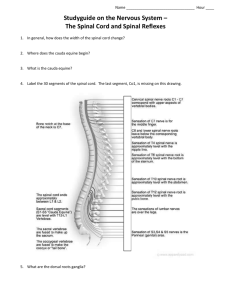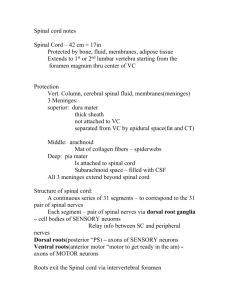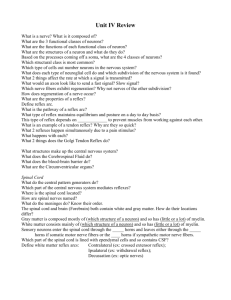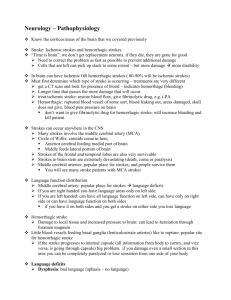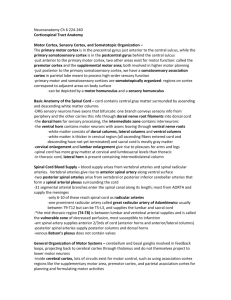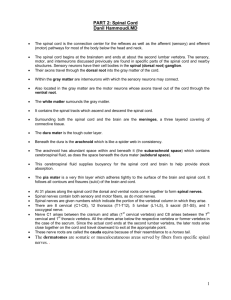File
advertisement
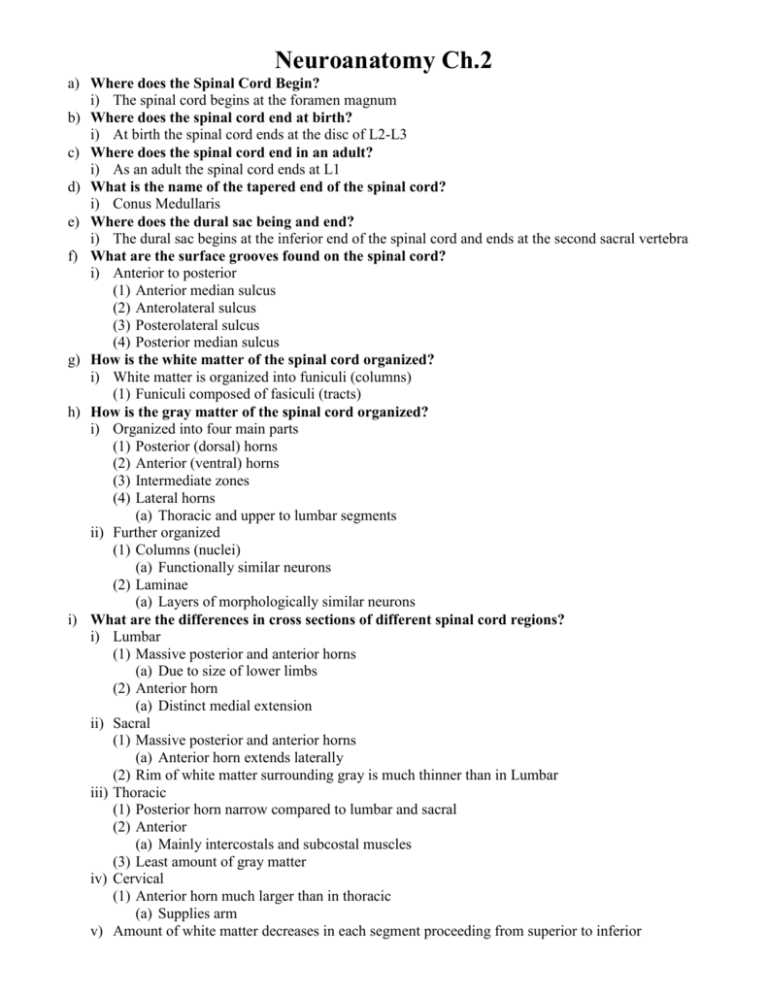
Neuroanatomy Ch.2 a) Where does the Spinal Cord Begin? i) The spinal cord begins at the foramen magnum b) Where does the spinal cord end at birth? i) At birth the spinal cord ends at the disc of L2-L3 c) Where does the spinal cord end in an adult? i) As an adult the spinal cord ends at L1 d) What is the name of the tapered end of the spinal cord? i) Conus Medullaris e) Where does the dural sac being and end? i) The dural sac begins at the inferior end of the spinal cord and ends at the second sacral vertebra f) What are the surface grooves found on the spinal cord? i) Anterior to posterior (1) Anterior median sulcus (2) Anterolateral sulcus (3) Posterolateral sulcus (4) Posterior median sulcus g) How is the white matter of the spinal cord organized? i) White matter is organized into funiculi (columns) (1) Funiculi composed of fasiculi (tracts) h) How is the gray matter of the spinal cord organized? i) Organized into four main parts (1) Posterior (dorsal) horns (2) Anterior (ventral) horns (3) Intermediate zones (4) Lateral horns (a) Thoracic and upper to lumbar segments ii) Further organized (1) Columns (nuclei) (a) Functionally similar neurons (2) Laminae (a) Layers of morphologically similar neurons i) What are the differences in cross sections of different spinal cord regions? i) Lumbar (1) Massive posterior and anterior horns (a) Due to size of lower limbs (2) Anterior horn (a) Distinct medial extension ii) Sacral (1) Massive posterior and anterior horns (a) Anterior horn extends laterally (2) Rim of white matter surrounding gray is much thinner than in Lumbar iii) Thoracic (1) Posterior horn narrow compared to lumbar and sacral (2) Anterior (a) Mainly intercostals and subcostal muscles (3) Least amount of gray matter iv) Cervical (1) Anterior horn much larger than in thoracic (a) Supplies arm v) Amount of white matter decreases in each segment proceeding from superior to inferior j) What are the signs and symptoms associated with lower motor neuron syndrome? i) Flaccid paralysis ii) Decreased superficial and deep reflexes iii) Spontaneous twitches or fasciculation iv) Atrophy occurs in denervated muscles k) What are the components of a motor neuron? i) Alpha motor neuron, its axon, and extrafusal muscle fibers innervated by the alpha motor neuron l) Why are lower motor neurons designated as the final common path? i) Because they are the only things to innervate extrafusal muscle fibers m) What muscles do the gamma motor neurons innervate and how do they affect muscle spindle sensitivity? i) Gamma motor neurons innervate intrafusal muscle fibers ii) Cause in increase in flexibility of spindles n) Which lamina in the ventral horn contains the lower motor neurons and how are these neurons somatotopically organized? i) Lamina IX ii) Somatotopically organized (1) 2 columns (a) medial column (i) uniform in size (ii) extends through length of cord 1. for most part (b) Lateral column (i) Varies segmentally 1. relatively small in thoracic segments a. only innervates intercostal and abdominal muscles 2. Large in cervical lumbar enlargements a. Several nuclei i. More lateral the nuclei more distal the muscle innervated o) What structures relay information to the CNS via Ia and Ib afferent fibers i) Muscle fibers ii) Ia (1) Intrafusal iii) Ib (1) Extrafusal p) Where are the Ia and Ib cell bodies located? i) Dorsal root ganglia q) What are the additional names for the myotatic reflex? i) Tendon reflex ii) Stretch reflex r) How does the myotatic reflex occur? i) Muscle stretched ii) Annulospiral receptor activation iii) Ia impulse directly excites lower motor neuron iv) Contraction of stretched muscle s) What are the additional names for the inverse myotatic reflex? i) Lengthening reflex ii) Autogenic inhibition reflex t) How does the inverse myotatic reflex occur? i) Tendon tension ii) Golgi tendon organ activation iii) Ib impulse excites interneuron (1) This then inhibits lower motor neuron iv) Relaxation of muscle whose tendon has increased tension v) Protects tendons from an injury from too much tension vi) Also important in hyperextension or hyperflexion of a joint u) What is the function of the Renshaw Cells? i) To regulate the firing of lower motor neurons and reciprocal contraction of antagonist muscles


